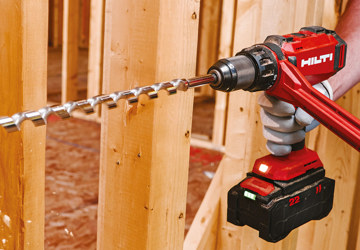

By John Muir, technical manager, Construction Fixings Association
The launch of EN1992-4:2018 was a historical moment in the design of post-installed anchors. For the first time in the long history of anchor design, the design provisions are published in an official European standard and not in guidelines or technical reports.
The inclusion of anchor design into a European code is a huge step forward for the anchor and fastener industry by bringing this issue to the attention of the structural engineer responsible for the design of the concrete structure.
EN1992-4 is part 4 of Eurocode 2 (Design of Concrete Structures), which provides a common approach for the design of reinforced concrete structures. Part 4 now covers the design of anchors for use in concrete and represents the state of the art design method for the industry.
In addition, the safety concept of anchors is now embedded in, and aligned to, the general global safety concepts for structural design within the Eurocodes and specifically in the structural design for reinforced concrete structures. The terminology and nomenclature of the design for anchors is aligned with that of the Eurocodes.
Furthermore, EN1992-4 defines the design of various fastening systems in one document for:
- Cast in studs and channels.
- Post-installed mechanical anchors.
- Post-installed resin anchors.
EN1992-4 covers the design of fasteners under static, quasistatic, fatigue and seismic actions, as well as under fire exposure.
Historical background
European regulatory systems in whatever form are designed to allow free movement of construction products and allow open competition. Prior to the introduction of the European Technical Approval Guidelines (ETAGs) in 1989, design of anchors was left to local guidelines and approvals.
The European regulatory framework for anchors was initially the Construction Products Directive (CPD), under which the European Organisation for Technical Assessments (EOTA) published the first anchor design guidelines as ETAG 001 Annex C1 in 1997. This initially covered mechanical anchor design and subsequent Technical Reports (TS’s) covered design provisions for bonded anchors, metal anchors under seismic loading, and also for anchor channel design.
Under the Construction Products Directive (CPD) products obtained European Technical Approvals (ETAs). When CPD was replaced by the Construction Products Regulation (CPR) in 1989, the ETAG’s were superseded by European Assessment Documents (EADs) as developed by EOTA. European Technical Assessments (ETAs) are issued under the CPR and provide the performance data tested against a list of ‘essential characteristics’ as defined by the EAD. This data is used to design an anchor, but was still using ETAG 001 Annex C.
The advent of the CPR, also meant that the design provisions could not be part of an EAD, but a harmonised Euronorm (hEN). The European Committee for Standardisation (CEN) was obliged to look at a standard for anchor design. Initially this was in the form of a Technical Specification (CEN/TS1992-4), which subsequently became EN1992-4 in 2018.
Current status for design
Design of anchors for general construction is covered by national law, however, the Eurocodes are accepted by all member states as the reference design codes and it is mandatory for member states to accept designs according to EN1992-4.
With the publication of EN1992-4, design has become simpler in that the design of all anchor types and loading regimes are included in one single design document. The performance data used in the design is also contained in a single document, namely the relevant ETA and the Declaration of Performance derived from it.
Changes to design from EN1992-4
There are relatively few changes to the fundamentals of anchor design as we have known it for the past 30 years. One major change is that the standard covers a broad fastener design, which includes post-installed anchors, cast-in fasteners and cast-in anchor channels.
A change that will have an impact is the introduction of a product dependent ‘sustained load factor’ for bonded anchors. This factor allows for the decrease in bond strength under sustained load, and could represent up to a 40% reduction where a high ratio of sustained load to total load is the case.
Summary
In summary EN1992-4 constitutes a change to a ‘standard’ from a ‘guideline’ and represents the state of the art in this field. It is also now an integral element in the Eurocode design code for concrete structures and encompasses the design of all post installed anchor types (mechanical and bonded anchors), as well as cast-in channels and studs, and all load conditions (seismic and fire).
This now makes anchor design a fundamental part of a structural engineer’s responsibility for good concrete design.
References: 1 European Technical Approval Guideline ETAG 001 (1997) ‘Mechanical Anchors…’ Annex C ‘design of anchors’.

Will joined Fastener + Fixing Magazine in 2007 and over the last 12 years has experienced every facet of the fastener sector – interviewing key figures within the industry and visiting leading companies and exhibitions around the globe. Will manages the content strategy across all platforms and is the guardian for the high editorial standards that the brand is renowned.





